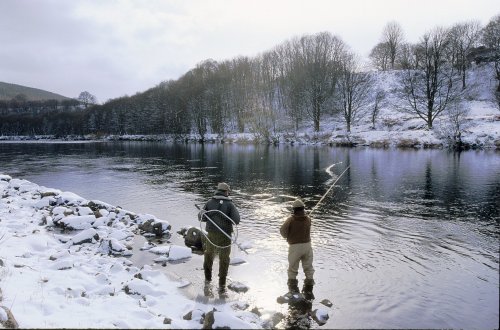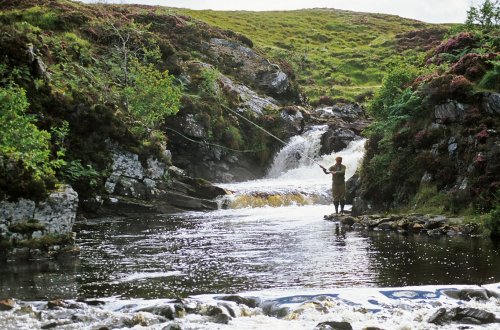Seasons significantly influence fishing activities in Scotland for several reasons.
Seasons significantly influence fishing activities in Scotland for several reasons. Firstly, the time of the year changes so much of how fish behave, and consequently how we fish for them. Secondly, the fish need to reproduce to sustain viable populations and we have introduced regulation in the form of ' close seasons' to avoid disturbing them at this vital time.
Fish are cold-blooded creatures. They are at the mercy of their environment, having no means of generating body warmth or getting rid of excess heat. The consequence of cold-bloodedness is that at the extremes of the Scottish temperature range, fish may find themselves in distress. Too cold, and they fall into a torpor, do not feed, and swim so slowly that they are prone to predators. At the other end of the temperature scale, the oxygen level in the water is depleted and as a result the fish struggle to intake a sufficient amount of oxygen. Another consequence is that unlike warm-blooded animals, they are unable to rid themselves of the heat of the surrounding water and perish due to heat exhaustion.
Each new season brings quite different behavioural activity in our fish. In Scotland, the winter cold causes ice to form on freshwater; the water in rivers and lochs becomes denser; and the metabolic processes of fish slow down to minimum levels. There is not much food available because insects are also cold-blooded and are not active in periods of penetrating cold. Curiously, it is not unusual to see upwing flies hatch from rivers in winter, but they are inconsistent and short-lived, with only a few insects surviving. These winter hatches are the exception, and the rule is that few flies come to the surface during cold spells. Due to limited feeding availability, fish feed on bottom-dwelling insects or species, but not as voraciously as they do in warmer conditions.
Pike feed during winter, but only for a short period on most days. They do not eat heavily because their sluggish metabolism requires low levels of energy input in cold conditions. Winter does not affect sea species to the same extent, due to the temperature buffering effect of coastal currents. They feed throughout the year, and winter offers excellent opportunities for cod fishing from our shores. This is often most successful at night and there is a hardy band of Scottish shore fishers who stay out through the dark winter nights on rocky promontories to fish for cod.
Spring brings relief from winter's deep chill and water temperatures rise in conjunction with lengthening warmer days. Food for freshwater fish is also more readily available, as insects and crustaceans become more active. Spring is a time of rejuvenation, and fish which have endured the winter months feed hard and freely. At this time of the year, after an enforced winter's fast they are at their most vulnerable to the angler - later into the summer they may be more fussy. There can be few more pleasant experiences than a spring day by the river or lochside with the birds singing, the cool fresh air sweet and clear, and the trees in bright green bud marking a new season full of hope and promise.
During the summer months, lochs are layered, with warm water at the surface and cooler water below. Trout may opt to lie deeper to find cooler water with higher levels of oxygen content. For a period of weeks fish are active only at dusk and dawn when insect hatches reach their height. The 'evening rise' is a typical manifestation of this phenomenon.
The cool of autumn and its increased rainfall heralds spawning time for some species before the returning onset of winter cold. Species that spawn in late autumn and early winter feed avidly in preparation for their fast, taking advantage of the cool, fresh conditions. A Scottish autumn can be splendid. The air is still mild, the days are mellow and rich, the colours intense and glowing. The fishing is revitalised after the 'dog days' of high summer. Salmon enter the rivers in large numbers and trout are brightly-coloured and active with spawning ahead. It is a time of plenty with the prospect of winter ahead - a time for the angler to 'make the most of it' before winter closes in.
Salmon spawning patterns are reflected in the legislated fishing seasons. There are times, throughout the country, when salmon fishing is prohibited. Local fishery boards determine the specific start and finish dates for this period. Some river systems have salmon actively spawning by mid-October, although most fish start a few weeks later. Most salmon are at the height of their spawning activity in November to December. Some are considerably later however, which affects the finish date designated by the fishery board. The River Tweed and its tributaries are open until the end of November, when fresh fish are still entering the system in considerable numbers, but this is not the norm and most systems close the season during or at the end of October.
Trout tend to return to their place of spawning in the period from October to December. The fish are in poor quality in the early months of the year following the rigours of spawning and their winter fasting period. The opening of the trout season in Scotland is March 15th, but this is too early to expect fish to be in tiptop condition, especially at higher altitudes and in the far north. Realistically, trout fishing is at its best in May when they have had a chance to replenish themselves and regain full physical fitness.














